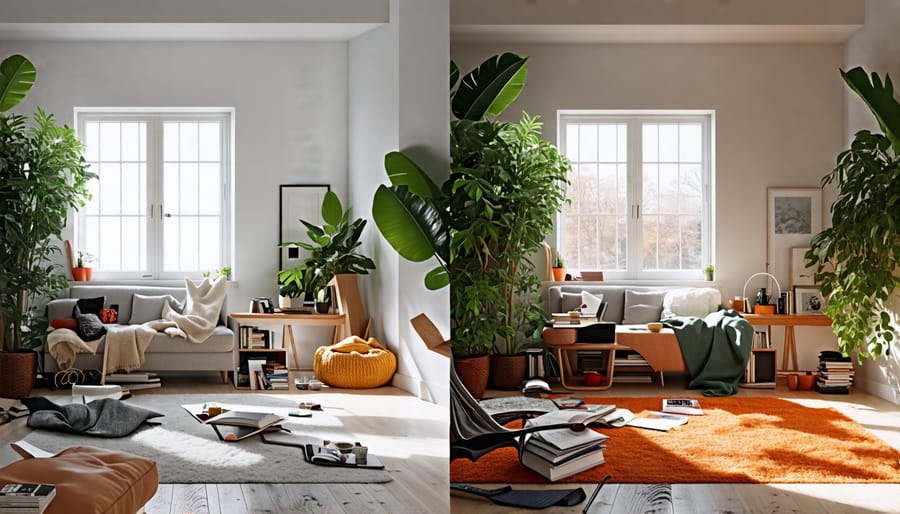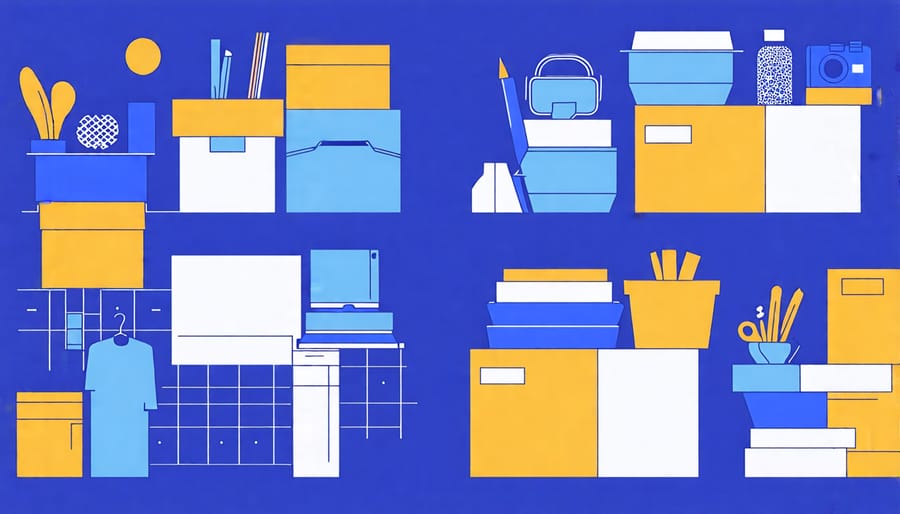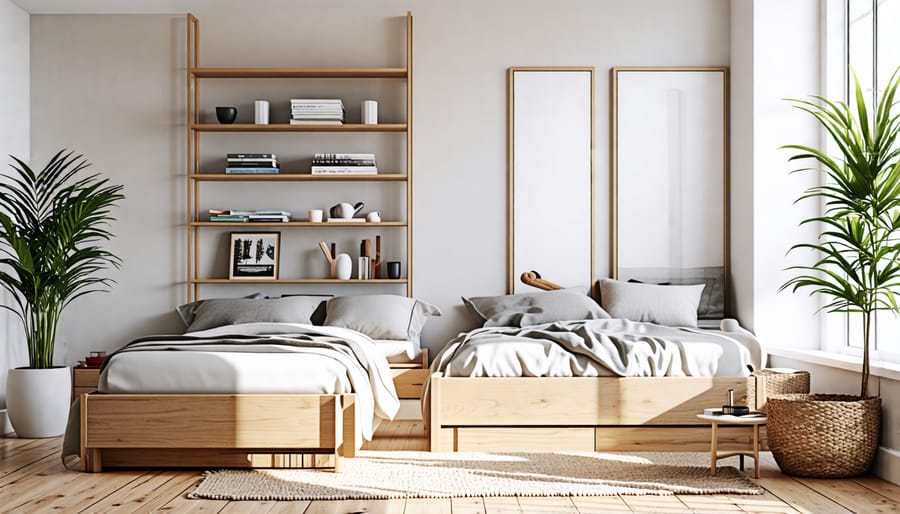Declutter ruthlessly, keeping only items that serve a purpose or bring joy. Organize remaining belongings into categories, assigning each a designated space. Invest in multi-functional furniture and storage solutions to maximize space and minimize visual clutter. Establish a “one in, one out” rule to maintain your minimalist home and create a more peaceful home environment.
Start with a Purge


The Four Box Method
The Four Box Method is a simple yet effective way to declutter your home. To get started, gather four boxes or containers and label them: Keep, Donate, Sell, and Discard. As you go through each room, sort your belongings into these categories. Items that you use regularly and love should go in the Keep box. If you have items in good condition that you no longer need, place them in the Donate box. For items of value that you don’t use, consider putting them in the Sell box to earn some extra cash. Finally, any broken, worn out, or useless items should go in the Discard box. Be honest with yourself during this process, and remember that letting go of things you don’t need can be liberating. Once you’ve sorted everything, put away the Keep items, and promptly dispose of the other boxes according to their labels. This method helps you make quick decisions and ensures that your space is filled only with items that you truly cherish and use.
Questions to Ask When Decluttering
When decluttering, ask yourself these questions to determine if an item is worth keeping:
1. Have I used this in the past year? If not, it’s likely you won’t miss it.
2. Does this item bring me joy or serve a specific purpose? If the answer is no, consider letting it go.
3. Do I have multiples of this item? Keep the best one and donate or discard the rest.
4. Is this item broken, damaged, or outdated? If it’s not worth repairing, it’s time to say goodbye.
5. Would I buy this item again today? If not, it may not align with your current lifestyle or needs.
6. Is this item taking up valuable space without adding value to my life? Be honest about the item’s true importance.
7. Could someone else benefit from this item more than I do? If so, consider donating it to a worthy cause.
By honestly answering these questions, you can make more informed decisions about what to keep and what to let go, bringing you closer to a clutter-free, minimalist home.
Embrace Multi-Purpose Items
One key principle of minimalist organization is to embrace multi-purpose items that serve double or even triple duty in your home. By selecting versatile goods, you can significantly reduce clutter and streamline your space. For example, instead of owning separate coats for spring, fall, and winter, invest in a durable, weatherproof jacket that adapts to various climates. In the kitchen, choose a high-quality, multi-functional pressure cooker that also serves as a slow cooker, rice cooker, and steamer. This single appliance can replace several others, freeing up valuable cabinet space.
When shopping for furniture, opt for pieces that offer hidden storage or can be used in multiple ways. A storage ottoman provides a comfortable place to sit and a spot to stash blankets or magazines. Similarly, a bed with built-in drawers eliminates the need for a separate dresser. In the bathroom, a sleek, wall-mounted dispenser can hold shampoo, conditioner, and body wash, reducing the number of bottles lining your shower.
By thinking creatively and selecting items that serve multiple purposes, you can dramatically reduce the amount of clutter in your home. As you shop, always ask yourself, “Can this item fulfill more than one function?” Embracing multi-purpose goods is a simple yet effective way to create a more minimalist, organized living space that is both functional and visually appealing. So, take a critical look at your belongings and start replacing single-use items with versatile alternatives to enjoy a clutter-free home.
Create Designated Spaces
Organizing Papers
To keep paper clutter under control, create a system for sorting mail, bills, and important documents as soon as they enter your home. Set up a designated spot, such as a tray or hanging organizer, where you can immediately place incoming papers. Schedule a regular time each week to go through this pile, discarding junk mail, filing important documents, and taking action on bills or time-sensitive items. Consider digitizing documents whenever possible to reduce physical paper storage. Establish a filing system that works for you, whether it’s a simple accordion folder or a more extensive filing cabinet. Label folders clearly and organize them in a way that makes sense to you, such as by category or date. Remember to purge your files annually, shredding or recycling anything that is no longer needed. By implementing these organizing papers strategies consistently, you can maintain a clutter-free, minimalist workspace.
Corralling Kids’ Items
Corralling kids’ clutter is key to maintaining a minimalist home. Assign a designated space for toys, like a specific closet, cupboard, or toy chest. Use clear, labeled bins to sort toys by type, making it easy for kids to find what they want and put things away. For art supplies, invest in a portable caddy with compartments to keep items organized and accessible. Regularly rotate toys and donate items no longer played with to keep collections manageable. Establish a “one in, one out” rule – for every new toy or item that comes in, an existing one gets donated. Involve kids in the process of purging and organizing to instill minimalist habits early on. Remember, less is often more when it comes to kids’ items. Embrace simplicity and focus on quality over quantity to create a clutter-free space that encourages imagination and independence.
Invest in Smart Storage
Investing in smart storage is key to achieving a minimalist, clutter-free home. Seek out space-saving storage solutions that are both functional and visually appealing. Opt for furniture pieces that serve multiple purposes, such as a storage ottoman or a bed with built-in drawers. Vertical storage is your friend – take advantage of wall space with floating shelves, pegboards, or a floor-to-ceiling bookshelf.
When it comes to organizing smaller items, consider clear, stackable containers that make it easy to see and access your belongings. Drawer organizers and dividers are perfect for keeping everything from utensils to office supplies neatly sorted. Over-the-door organizers are a game-changer for maximizing space in closets, pantries, or bathrooms.
Invest in quality, durable storage solutions that align with your minimalist aesthetic. Look for sleek, streamlined designs in neutral colors that blend seamlessly with your decor. Some great product ideas include:
1. Woven baskets for stylish, concealed storage
2. Magnetic knife strips for a clutter-free kitchen
3. Vacuum storage bags for seasonal clothing and bedding
4. Wall-mounted file organizers for papers and documents
5. Tension rods for creating additional hanging space in closets
Remember, the key to successful minimalist organization is choosing storage solutions that fit your specific needs and complement your living space. By investing in smart, intentional storage, you’ll create a home that feels both organized and serene.

Keep Surfaces Clear
Minimalist spaces often feature clear, uncluttered surfaces that create a sense of calm and order. By keeping counters, tables, and other flat surfaces free of excess items, you allow the beauty of your home’s architecture and design to shine through. To maintain clear surfaces, start by removing anything that doesn’t serve a purpose or bring you joy. Be ruthless in your decluttering, and find alternative storage solutions for necessary items that tend to accumulate on surfaces.
Establish a habit of putting things away immediately after use, and designate a specific spot for each item to make tidying up quick and easy. Consider using attractive trays, baskets, or boxes to corral smaller items and keep them organized. For frequently used items like keys or mail, create a dedicated landing zone near the entryway to prevent them from cluttering up other surfaces. By implementing these strategies and committing to maintaining clear surfaces, you’ll create a minimalist haven that feels spacious, purposeful, and visually appealing.
Conclusion
Adopting a minimalist approach to home organization can lead to a more peaceful, stress-free living environment. By focusing on the essentials and letting go of excess clutter, you can create a space that feels calming and purposeful. Remember, the journey to a minimalist home is a gradual process. Start small by decluttering one area at a time, and celebrate each milestone along the way. As you experience the benefits of a more organized space, you’ll find motivation to tackle larger projects. Embrace the idea that less is more, and focus on surrounding yourself with items that bring you joy and serve a functional purpose. With patience, persistence, and a commitment to living with less, you can transform your home into a haven of minimalist tranquility. Embrace the freedom and clarity that comes with a clutter-free life, and enjoy the newfound sense of peace and purpose in your space.
